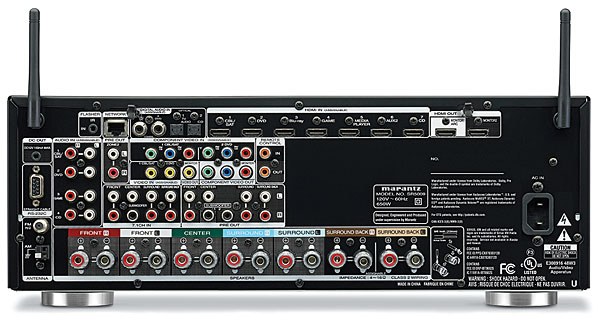Marantz SR5009 AV Receiver Review

AT A GLANCE
Plus
Wi-Fi, AirPlay, Bluetooth built in
Analog multichannel ins and outs
Minus
No HDCP 2.2
THE VERDICT
Though it lacks the latest UHD video future-proofing, this mid-line Marantz delivered great sound and solid value.
D+M has a leading role in the audio/video receiver market. It’s actually an amalgamation of two former companies with markedly different (though both distinguished) histories. Denon, born in 1910 and known for a time as Nippon Columbia, was originally a manufacturer of gramophones and discs in Japan. Marantz, in contrast, was born in the U.S.A. in the early 1950s when Saul Marantz of Kew Gardens, New York, started building preamps in his home.
After numerous corporate permutations (which included a three-decade relationship between Marantz and Philips), Marantz and Denon merged in 2002 into what is now called the D+M Group. In 2014, the pro divisions of both brands were acquired by inMusic Brands, a maker of DJ equipment. However, the consumer divisions continue to market AV receivers and other audio products under the D+M umbrella.
Atmos, No. Triple Wireless, Yes.
The SR5009 ($899) is one of three new Marantz AV receivers, also including the more powerful SR6009 ($1,299) and Dolby Atmos–capable SR7009 ($1,999). No, the 7-channel SR5009 doesn’t include Atmos decoding—with the exception of Onkyo, which offers three 7.1-channel Atmos-compliant models, AVR makers have chosen to focus their initial Atmos efforts on 9- and 11-channel models that can drive a minimum of four height speakers along with the basic 5.1-channel configuration. But this receiver does offer what I call the wireless triple threat—Wi-Fi, AirPlay, and Bluetooth—and they’re all free of awkward extra-cost dongles. That potentially saves you hundreds and boosts our value rating.
Marantz receivers have a unique convex-curved front panel with a small porthole display. Some models augment the porthole with a larger display hidden behind a flip-down door, though this receiver does not. If you depend on the front-panel display, the porthole’s modest size might be a limitation. The buttons (for sound mode, zone, dimming, etc.) that normally would be behind the door are instead beneath the porthole in plain view, reduced to slivers to avoid marring the clean visual design.

This $899 receiver offers a fuller back panel than, say, a typical $600 model does. There are eight HDMI inputs and two outputs, version 2.0, but minus the HDCP 2.2 digital rights management used for UHD. This is hardly unusual for most 2014 AVR models, but it isn’t an easily ignored omission, either. While it’s hard to know exactly what ramifications this might have for the passthrough of Ultra HD content, it’s clear that at least some future streams and probably the upcoming UHD Blu-ray Discs (now scheduled to appear by the end of 2015) will be encoded with HDCP 2.2, and even HDMI 2.0-compliant models today that lack this latest copy-protection scheme would likely block such signals. The impact of this on your buying decision will depend on how critical you deem future-proofing for UHD video switching.
Also present on the SR5009 are three HD-capable component video inputs and one output. Some of our readers have expressed concern about the disappearance of analog multichannel interfaces from sub-$1,000 receivers. They will be glad to find the 7.1-channel input and 7.1-channel output (with two monophonic subwoofer connections) on this one. The multi-ins would play nice with the multi-outs on your high-res SACD disc player, and the preamp-outs would allow the receiver to serve as a preamp/processor, feeding a separate multichannel power amp. Stereo analog inputs (four) and digital coaxial/optical inputs (two each) are reasonably plentiful, so this receiver will support your two full racks of legacy components, though changing the litter boxes for your 30 cats is still a responsibility you must bear alone.
With Denon and Marantz sharing the D+M stable, it’s no surprise that the SR5009 and some Denon receivers have several traits in common, including the graphic user interface (with its good-looking and highly readable font) and the slightly simplified remote control. Both brands supply cardboard microphone stands for use during auto setup, a helpful plus. Despite these similarities, the two brands have traditionally had different cosmetics and (in my experience) voicing, with Denon typically offering a more “clinical” sound and Marantz a more “euphonic” one. More on that later.
The SR5009 is rated at 100 watts per channel with two channels driven. Another Marantz tradition is to maintain 75 percent of rated power with five channels driven; see our measurements to find out whether this model measures up to that yardstick. Room correction is MultEQ XT, Audyssey’s second-best system—and I consider Audyssey’s second-best to be very good indeed.
In addition to AirPlay and Bluetooth, this receiver can use DLNA via Wi-Fi or Ethernet connections to grab music from a PC, network attached storage drive, or USB external drive. That includes high-resolution files such as DSD; FLAC, and WAV up to 192 kilohertz and 24 bits; ALAC and AIFF up to 96/24; and lossy MP3 and AAC. Gapless playback is supported for all formats, not just for the Apple-approved ones, and Marantz says this is an exclusive (glad I asked!). A sticker on the front panel celebrates the presence of Spotify Connect audio streaming.






























































